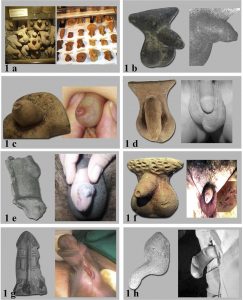Amerika Üroloji Kongresi, 18-21 Mayıs 2018 San Francisco
THE JOURNAL OF UROLOGY
April 2018 Volume 199, Issue 4, Supplement, Page e1243
DOI: https://doi.org/10.1016/j.juro.2018.02.3028

FR-08 AUA 2018
INTRODUCTION AND OBJECTIVES
When history of medicine was examined people have been seeking for cure in many different areas such as magicians, traveler healers, drug dealers, local physicians, scientific Hippocratic physicians and the temples of the gods. Among these the most popular one was healing practices applied in temples of healer gods. In this article, we exhibited the male genital organ votives presented to gods expressing urogenital diseases mutually with pointed out diseases especially in the temples of ancient Greek and Roman periods. 
METHODS
The ancient healer gods, ancient male urogenital diseases and the physicians who first described them were researched. Male urogenital votive samples representing a disease were researched, examined, and presented together with presentday equivalents.
RESULTS
Patients wishing treatment in the temples represent to gods their ill organs. (Figure1a) Among these, it was seen that some male genitalia votives represented some urogenital diseases. Both adult and child phimosis examples were also seen. (Figure1b,c) For the first time in 34 AD, mentioned by Celsus, varicocele was expressed in a votive exhibited in a gallery as the left testicle being lower and bigger. (Figure1d) Two bumps on the Etrusco-Roman period penis votive exhibited in Italy, Castellana Archaeological Museum pointed out the penile hemangiomas. (Figure1e) The view of skin in the pubic area of the votive from ancient Greek period in Berlin Altes Museum, Germany brought to mind hidradenitis suppurativa lesions. (Figure1f) Hypospadias, for the first time in 4. century BC, was defined by Aristotle, Galen of Pergamon, in the 2nd century AD, has revealed the term hypospadias for this condition. The first representation of hypospadias have been identified in a unique the ancient Greek period phallus vase discovered in Egypt and exhibited in the British Museum, is a phallus vase without sample. (Figure1g) Apart from these, a votive phallus offered to Minoan Peak Temple in 3000 BC, probably representing Peyronie disease or penile curvature, has been viewed as a rare example. (Figure1h)
CONCLUSIONS
It was seen that very few of genital organ votives gave information about a disease. On these votive models, a disease was tried to be expressed by creating appearances representing the illness. These very rare examples were remarkable visual evidences of ancient diseases.
Ekrem Guner, Sebnem Izmir Guner, Volkan Tugcu, Istanbul, Turkey
University of Health Sciences, Dr. Sadi Konuk Education and Training Hospital, Bakirkoy, Dept. of Urology, Istanbul
Esenyurt University, Kolan International Hospital, Sisli, Dept. of Hematology and Bone Marrow Transplantation, Istanbul

